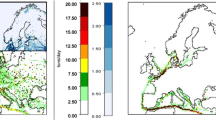Abstract
A modelling study, supported by a sensitivity analysis, is proposed for assessing the distinctive features of the dispersion of ship emissions in the Venice Lagoon. The main aspects on which the analysis focuses are the appropriate parameterization of the turbulence variables in the lagoon, the proper treatment of the lagoon-sea surface temperature and the evaluation of different parameterizations for the plume rise to describe the pollutant emissions from moving ships. The results of the study are discussed in the context of the environmental impact assessment of present and future scenarios.
Access this chapter
Tax calculation will be finalised at checkout
Purchases are for personal use only
Similar content being viewed by others
References
Bratseth AM (1986) Statistical interpolation by means of successive corrections. Tellus 38A:439–447
Tinarelli G, Anfossi D, Bider M, Ferrero E, Trini Castelli S (2000). A new high performance version of the Lagrangian particle dispersion model SPRAY, some case studies. In: Gryning SE, Batchvarova E (eds) Air Pollution modelling and its application XIII, vol 23. Plenum Press, New York, pp 499–506. ISBN: 0-306-46188-9
Author information
Authors and Affiliations
Corresponding author
Editor information
Editors and Affiliations
Questions and Answers
Questions and Answers
Questioner: Jaakko Kukkonen
Question: Which emission model did you use? Was it based on the AIS signals or some other data? There are various models for evaluating ship emissions, and these can provide substantially different results.
Answer: We used the methodology described in the EMEP/EEA Air Pollutant Emission Inventory Guidebook (2013) using the ship characteristics and setting time modulations using the daily ship movements to/from the ports given by the local Port Authority of Venice.
Questioner: Jeff Weil
Question: Did you account for the increased relative velocity on the emission strength as you did for the plume buoyancy and plume rise? The increased relative velocity would also dilute/reduce the mass emission per unit length of the plume as it does for the buoyancy per unit length, F b /(u a + u ship )
Answer: No, we did not. We were not considering the exact position of each moving ship because this information was not available. This means we considered the total emission spread along the entire trajectory for each different ship category, as if the entire trajectory was homogeneously filled by emitting ships. Along the whole trajectory, the total emitted mass had to be conserved and we did not apply any correction to the emission strength.
Questioner: Peter Viaene
Question: You consider the flattening of the plume on your plume rise. Wouldn’t the extra turbulence in the wake cause a dilution of the concentration?
Answer: The ships are moving along the canal with a velocity ranging from 12 to 20 km/h, so we do not expect a possible wake turbulence to be significantly effective in diluting the plume. In addition, differently from most vehicles, the plume is emitted from a chimney (on top, in the vertical) and not from an exhaust pipe (at the rear side, in the horizontal).
Questioner: Wouter Lefebvre
Question: How did the public react to the ‘small’ results, i.e. only difference in NOx of 0.3 μg/m3 max, which is not measurable?
Answer: The complete study, including also all other contributions (effects on sediments, lagoon waves, noise etc.) at this time have not yet been presented to the public. The main result for the air pollution is the shift of the impact area from the Venice city centre and surrounding to the industrial and residential areas of Marghera and Mestre, thus affecting a different part of the population. Anyway, we note that considering we are simulating the emission of only a part of a single source category, a contribution of 0.3 μg/m3 of NOx on the yearly average can be regarded as non-negligible.
Rights and permissions
Copyright information
© 2018 Springer International Publishing AG
About this paper
Cite this paper
Castelli, S.T. et al. (2018). Modelling the Dispersion of Ship Emissions in Different Scenarios and Sensitivity Analysis. In: Mensink, C., Kallos, G. (eds) Air Pollution Modeling and its Application XXV. ITM 2016. Springer Proceedings in Complexity. Springer, Cham. https://doi.org/10.1007/978-3-319-57645-9_42
Download citation
DOI: https://doi.org/10.1007/978-3-319-57645-9_42
Published:
Publisher Name: Springer, Cham
Print ISBN: 978-3-319-57644-2
Online ISBN: 978-3-319-57645-9
eBook Packages: Earth and Environmental ScienceEarth and Environmental Science (R0)




